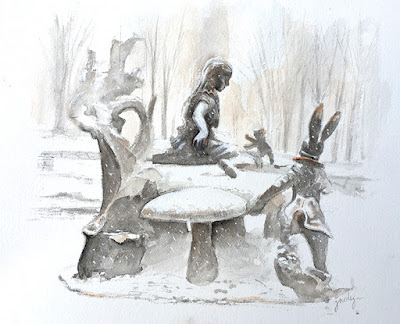when I picked the name transference for the show I was only thing in terms of the idea of transferring emotion or mood through art..I was not thinking in the Freudian term etc..but it is highly interesting from both angles.
Transference
One of the most important concepts associated with the psychodynamic tradition is the idea of transference. Transference is a simple appearing idea that has to do with the way people understand one another and form relationships with one another. As its name suggests, it involves the idea of transferring something from one place to another. What is being transferred in this case is an understanding of a person. Where it is being transferred to is onto another person. When transference is occurring, basically what is happening is that we are trying to understand someone (usually someone we don't know very well) by making an assumption that they are similar to someone else, and will thus feel and behave in ways that are similar to how that other person would feel and behave.
Transference is a very fundamental process that human beings are constantly doing for better and for worse. Like most fundamental things we can't help but do, such as being hungry, communicating via body language even when we do not speak, or finding one's self sexually attracted or repulsed to another, it is not at all dangerous in moderation, but can create problems when done to excess. More to the point, the act of transference, like these other fundamental human processes, reveals and illuminates our motives and our thoughts; thoughts and motives that would otherwise remain hidden away from others and often even from ourselves (especially from ourselves Freud would say). Our acts of transference provide an information rich window into what we are desiring and what we wish to avoid. What we read into other people reveals our secret prejudices and our unfulfilled wishes. What is particularly wonderful about transference information is that it reveals or illuminates motives that people are often themselves unaware of having, or loath to fess up to. Part of Freud's genius was to recognize not only that transference was something that occurred on a regular basis, but also to realize that the information about personal motives that a person's transference activity revealed about him or her could be used as a therapeutic tool to promote self-understanding and healing.
Some therapists would disagree with the characterizations I'm about to make, but this is how I see it: transference is something that people do most all the time. It is itself an instance of a more fundamental and general process of perception that all people do which is to read patterns into things that aren't there in an effort to make sense out of incomplete data.
A Relationship Illusion
Consider the following illustration which, for those of you listening to this via podcast consists of the following things. Three circles are arranged so that they are more or less equidistant. Each circle has a pie-shaped wedge cut out of it so that it looks like a pac-man, or a pie with a piece missing. These circles are oriented so that the missing wedges face each other. That is the visual description of what is in the image, but that is probably not the first thing you see when you look at the image. The first thing you are likely to see is a single triangle. There is no triangle really there, however. There are just three circles with wedges cut out of them. Your eyes see the circles with wedges too, but your brain interprets these three independent things into a single instance of a triangle; in doing so it adds things into the mix that aren't there so as to organize a familiar pattern.
How is it possible to have such a strong optical illusion of a triangle present in the image when there is no triangle there? Basically, what makes this possible is that people viewing the figure have a lot of prior experience with triangles, and "instinctively" or reflexively read the whole figure of the triangle into existence based on features of the image that suggest features of triangles we've known in the past. This processing occurs at an automatic, unconscious and non-verbal level of perception within the brain; you have no choice but to see the triangle, just as you have no choice not to understand the words on this page (or the sounds in your ear). Optical illusions of this type illustrate what the brain is, which is a sort of pattern matching and pattern generating machine. Brains basically find patterns in the world and when things aren't already in patterns we recognize, we try to fit patterns that are familiar with onto the data we have in an effort to make a familiar pattern appear. This automatic tendency is the basis of optical illusions, and it is also part of the basis of paranoia and a whole lot of interesting psychological phenomena, among them transference.
If seeing the triangle is an example of an optical illusion, transference is a kind of relationship illusion. It occurs easily and effortlessly when we first meet someone and try to form an understanding of who they are based on first impressions. It is an unconscious process, in that it occurs without effort, and does not announce itself. You only know it has happened when the person you thought you had a handle on goes and does something completely unexpected.


No comments:
Post a Comment